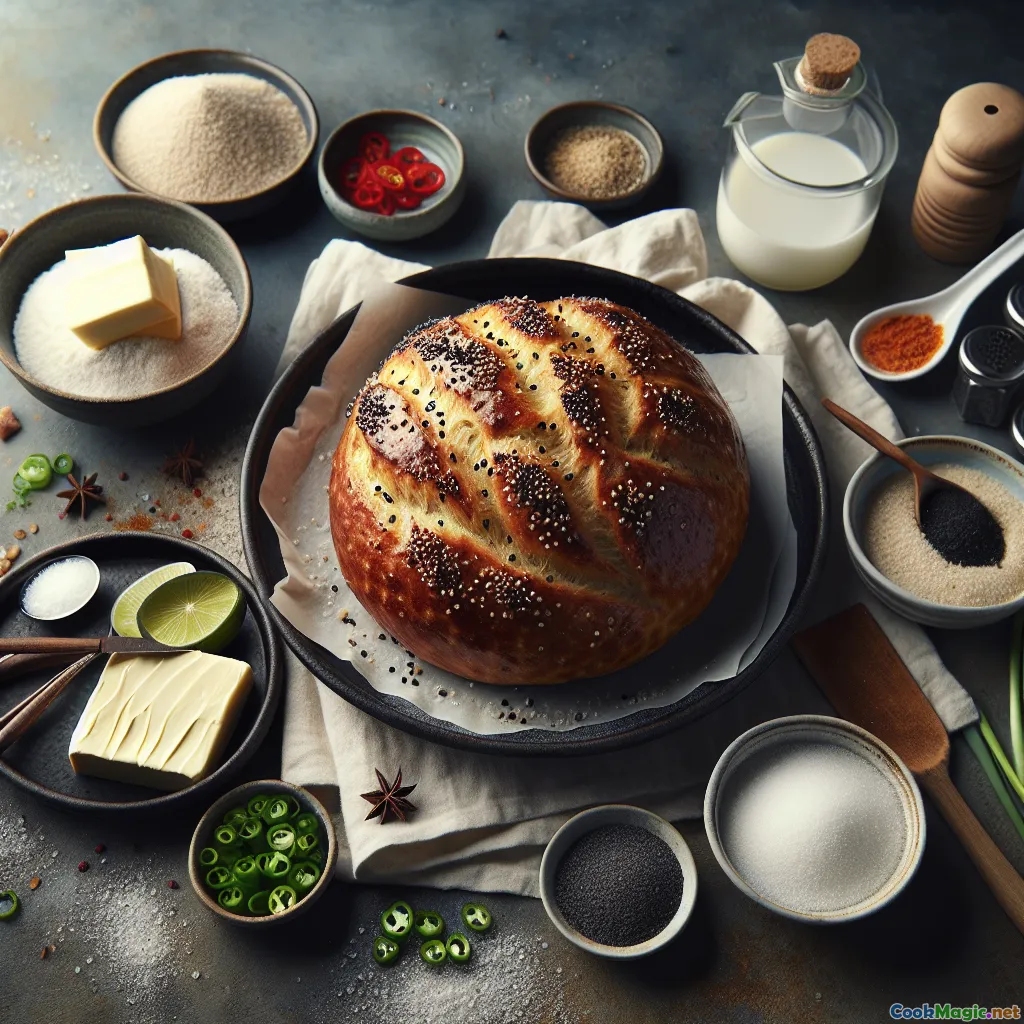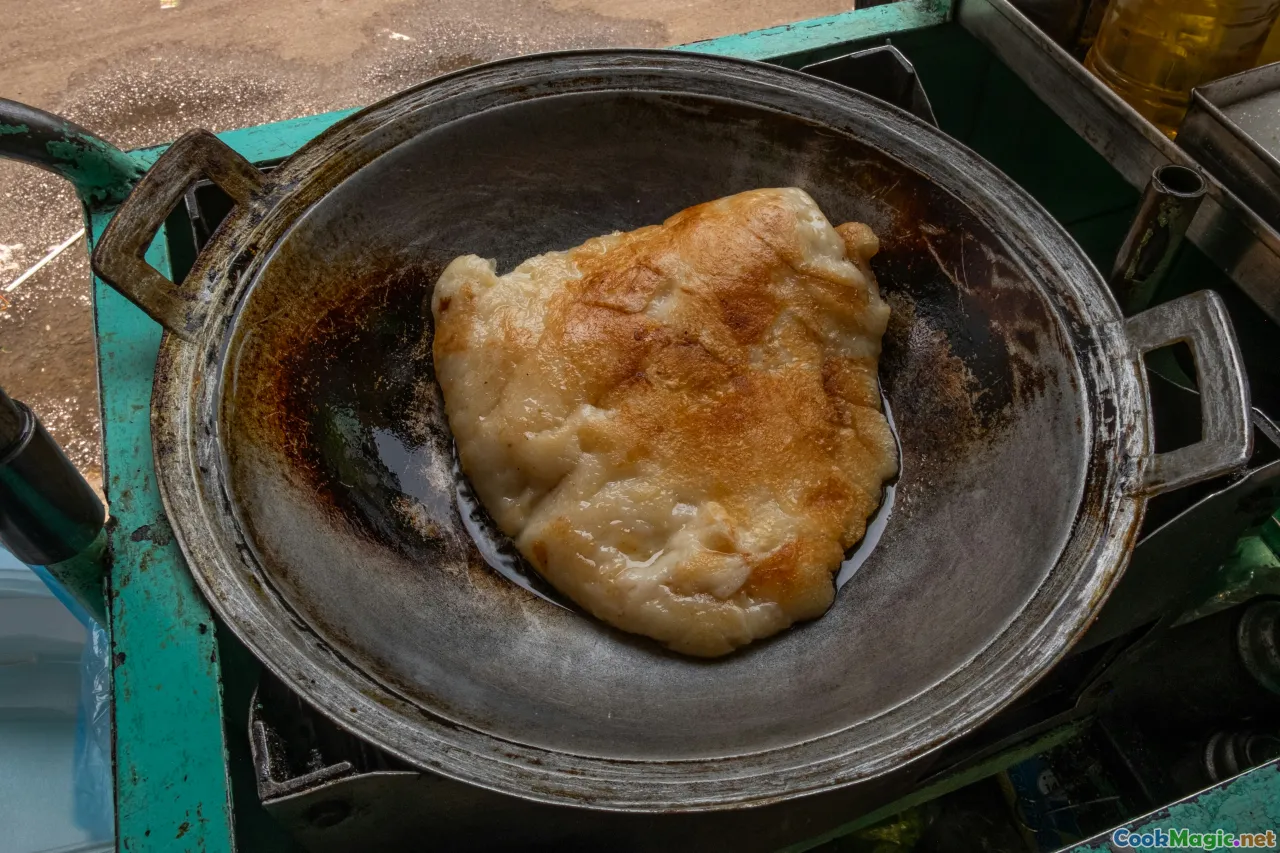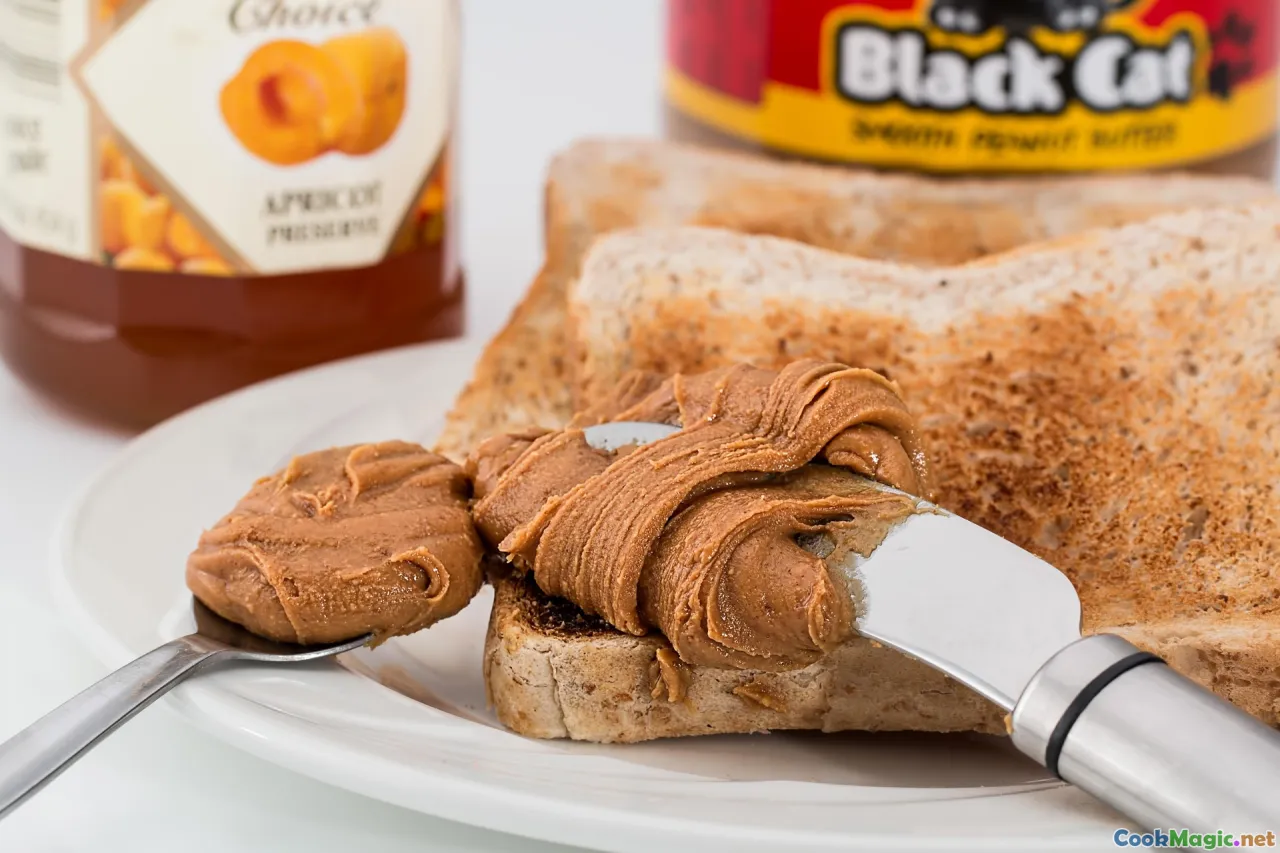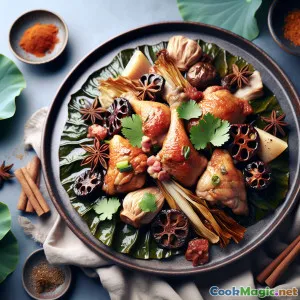
丁莫配黑盐黄油
(Tingmo with Black Salt Butter)
(0 评论)食材
-
450 grams 通用面粉
(High-protein flour yields chewier crumb)
-
260 ml 温水(38–43°C)
(Warm, not hot, to keep yeast active)
-
7 grams 速发酵母
(Active dry: use 9g and proof first)
-
10 grams 砂糖
(Feeds yeast and boosts browning flavor)
-
6 grams 细盐
(Seasoning for dough; keep away from yeast at first)
-
4 grams 泡打粉
(Traditional Tibetan cooks sometimes add for extra puff)
-
15 ml 中性油
(Can substitute melted ghee for aroma)
-
5 ml 中性油(用于抹油)
(Prevents sticking while shaping and proofing)
-
8 pieces 烘焙纸方块
(For easy lifting into steamer)
-
1000 ml 蒸煮用水
(Hot water to generate steady steam)
-
100 grams 无盐黄油,室温软化
(Room temperature for easy mixing)
-
1.5 grams 黑盐(kala namak),细磨成粉
(Start small; it’s intensely savory-egg flavored)
-
5 grams 烤芝麻
(Adds nuttiness to the butter)
-
10 grams 香葱,切成细薄片
(Green parts only for color and freshness)
-
1 grams 青柠檬皮屑
(Bright citrus lift; lemon works too)
-
0.5 grams 辣椒 flakes
(Add a whisper of heat; adjust to taste)
(High-protein flour yields chewier crumb)
(Warm, not hot, to keep yeast active)
(Active dry: use 9g and proof first)
(Feeds yeast and boosts browning flavor)
(Seasoning for dough; keep away from yeast at first)
(Traditional Tibetan cooks sometimes add for extra puff)
(Can substitute melted ghee for aroma)
(Prevents sticking while shaping and proofing)
(For easy lifting into steamer)
(Hot water to generate steady steam)
(Room temperature for easy mixing)
(Start small; it’s intensely savory-egg flavored)
(Adds nuttiness to the butter)
(Green parts only for color and freshness)
(Bright citrus lift; lemon works too)
(Add a whisper of heat; adjust to taste)
营养
- 份量: 8
- 每份大小: 1 bun (75g) with 10g butter
- Calories: 260 kcal
- Carbohydrates: 0 g
- Protein: 6 g
- Fat: 10 g
- Fiber: 1.5 g
- Sugar: 2 g
- Sodium: 420 mg
- Cholesterol: 25 mg
- Calcium: 30 mg
- Iron: 2.2 mg
制作步骤
-
1 - Activate the Yeast:
In a small bowl, whisk warm water with sugar and yeast. Let sit until foamy, 5–10 minutes. If using active dry yeast, ensure a creamy foam forms.
-
2 - Combine Dry Ingredients:
In a large bowl, whisk flour, salt, and baking powder (if using) until evenly distributed.
-
3 - Make and knead the dough:
Pour the yeast mixture into the dry ingredients with 1 tbsp oil. Mix to a shaggy dough, then knead on a lightly floured surface until smooth and elastic, 8–10 minutes.
-
4 - First Rise:
Place dough in a lightly oiled bowl, cover, and let rise in a warm spot until doubled, 45–60 minutes depending on room temperature.
-
5 - Mix black salt butter:
Mash softened butter with kala namak until uniform. Fold in sesame, scallions, lime zest, and chili flakes if using. Chill to firm while dough proofs.
-
6 - Roll Out the Dough:
Punch down dough. Roll into a 30×40 cm rectangle. Lightly brush surface with a film of oil to help define the layers.
-
7 - Shape tingmo twists:
From the long side, roll into a tight log. Cut into 8 even pieces. For each piece, slit lengthwise almost through, open like a book, and twist into a rope; coil into a rose. Place each on a parchment square.
-
8 - Second Proof:
Cover shaped buns and let puff until slightly swollen and soft to the touch, about 20 minutes.
-
9 - Prepare steamer:
Bring water to a steady boil in a steamer pot or wok. Line steamer with parchment or lightly oil to prevent sticking.
-
10 - Steam the buns:
Arrange buns with space to expand. Steam over medium-high heat for 12–15 minutes. Turn off heat and rest covered 2 minutes to set.
-
11 - Serve with black salt butter:
Split warm tingmo and spread with the kala namak butter. The heat will bloom its sulfurous-umami aroma beautifully.
-
12 - Store and reheat:
Keep buns covered up to 1 day at room temp. Re-steam 3–4 minutes or microwave briefly with a damp towel until fluffy.
In a small bowl, whisk warm water with sugar and yeast. Let sit until foamy, 5–10 minutes. If using active dry yeast, ensure a creamy foam forms.
In a large bowl, whisk flour, salt, and baking powder (if using) until evenly distributed.
Pour the yeast mixture into the dry ingredients with 1 tbsp oil. Mix to a shaggy dough, then knead on a lightly floured surface until smooth and elastic, 8–10 minutes.
Place dough in a lightly oiled bowl, cover, and let rise in a warm spot until doubled, 45–60 minutes depending on room temperature.
Mash softened butter with kala namak until uniform. Fold in sesame, scallions, lime zest, and chili flakes if using. Chill to firm while dough proofs.
Punch down dough. Roll into a 30×40 cm rectangle. Lightly brush surface with a film of oil to help define the layers.
From the long side, roll into a tight log. Cut into 8 even pieces. For each piece, slit lengthwise almost through, open like a book, and twist into a rope; coil into a rose. Place each on a parchment square.
Cover shaped buns and let puff until slightly swollen and soft to the touch, about 20 minutes.
Bring water to a steady boil in a steamer pot or wok. Line steamer with parchment or lightly oil to prevent sticking.
Arrange buns with space to expand. Steam over medium-high heat for 12–15 minutes. Turn off heat and rest covered 2 minutes to set.
Split warm tingmo and spread with the kala namak butter. The heat will bloom its sulfurous-umami aroma beautifully.
Keep buns covered up to 1 day at room temp. Re-steam 3–4 minutes or microwave briefly with a damp towel until fluffy.
关于 丁莫配黑盐黄油 :的更多信息
Overview
Tingmo (also spelled tingmomo or t’mo) is a pillowy Tibetan steamed bread, typically shaped into elegant twists or roses and served alongside hearty stews like thukpa, spicy pickles, or creamy gravies. This recipe celebrates tingmo’s tender, layered crumb with a modern flourish: a compound butter laced with kala namak, also known as black salt, prized across the Indian subcontinent for its sulfurous, eggy aroma and deep savory character. The result is a comforting, cloud-soft bun that tears into steam-perfumed wisps, then melts into a butter that is at once fragrant, salty, and faintly smoky.
What Makes Tingmo Special
Unlike baked breads that depend on a Maillard crust, tingmo is all about interior texture. Steam sets starches rapidly, preserving moisture and producing a pure, snow-white crumb. The classic twist is more than decorative—it creates delicate layers that pull apart in tender sheets. In Tibet and Himalayan communities, tingmo is a versatile companion to both vegetarian and meat dishes, balancing chilies, fermented flavors, and yak-butter richness with its neutral warmth.
The Black Salt Butter
Kala namak transforms simple butter into something striking. Its mineral-rich tang and gentle sulfur notes mimic the savoriness of eggs, which means a small pinch carries big flavor. Be conservative—too much and it can dominate. Here, a whisper of sesame for nuttiness, scallions for freshness, and a touch of lime zest for lift round out the butter without stealing the spotlight. Spread it on hot tingmo and you’ll see why this pairing works: the butter loosens, scent blooms, and every fold of dough becomes a flavor conduit.
Technique Tips
- Hydration and kneading: Tingmo benefits from a medium-hydration dough that becomes silky after 8–10 minutes of kneading. If it feels tacky, a light dusting of flour on your hands—not the board—keeps gluten development on track.
- Double leavening: Some Tibetan cooks add a bit of baking powder alongside yeast. At altitude, it ensures a buoyant rise; at sea level, it helps define layers. This recipe keeps it optional so you can tailor the crumb.
- Shaping for layers: The roll-slit-twist method creates a rose shape with plentiful seams that trap steam. Those seams act like little pistons, pushing the bun upward as it cooks.
- Steaming discipline: Keep a steady, medium-high simmer—too low yields dense buns; too vigorous can deform them. After steaming, let buns rest covered for 2 minutes so the crumb sets and doesn’t collapse.
Make-Ahead and Storage
- The butter can be made up to 5 days ahead; refrigerate and bring to room temperature for easy spreading.
- Shaped buns can be refrigerated, covered, for up to 8 hours. Steam straight from the fridge, adding 1–2 minutes.
- Leftover tingmo freeze well. Wrap individually and freeze up to 1 month. Re-steam from frozen for 6–8 minutes.
Serving Suggestions
- Classic: Serve with hearty Tibetan or Himalayan stews, dal, or spicy pickles.
- Brunch: Pair with soft-scrambled eggs or tofu, letting kala namak bridge flavors.
- Snack: Tear and dip into chili crisp swirled with a spoon of the compound butter.
Cultural Notes
Tingmo is part of a broader family of steamed breads across Central and East Asia, yet it’s distinctly Tibetan in its twist and in its role at the table—soaking up broths, tempering heat, and offering comfort at altitude where baking conditions can be challenging. The use of strong dairy flavors, like yak butter, is traditional in Tibetan cuisine; here, cow’s milk butter softened with kala namak nods to that richness while making the ingredients accessible worldwide.
Ingredient Insights
- Flour: A slightly stronger all-purpose flour yields better chew. If using cake or very soft flour, hold back a tablespoon or two of water.
- Kala namak: Look for rock salt that is pinkish-gray; grind fine for even dispersion. Start small and taste as you go.
- Oil vs. ghee: Ghee provides a nutty aroma close to Himalayan flavors; neutral oil keeps the bread purely milky-sweet.
Troubleshooting
- Dense buns: Usually under-proofing or weak steam. Let the second rise create visible puff and keep water at a steady boil.
- Rubbery texture: Over-kneading or too little fat can tighten crumb. Knead just to smooth elasticity and maintain moderate hydration.
- Overpowering butter: Reduce kala namak by half and add a squeeze of citrus to brighten.
Why This Works
Steam preserves tenderness; the twist multiplies layers; and kala namak butter amplifies the bread’s gentle sweetness with deeply savory, aromatic notes. It’s a beautiful union of texture and aroma—humble ingredients elevated by technique and tradition.
























